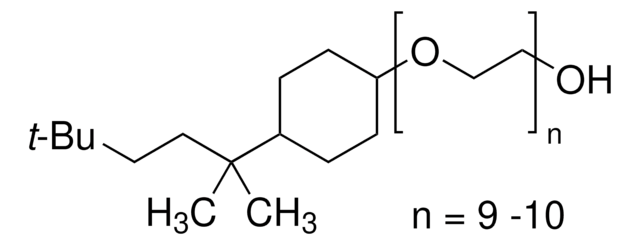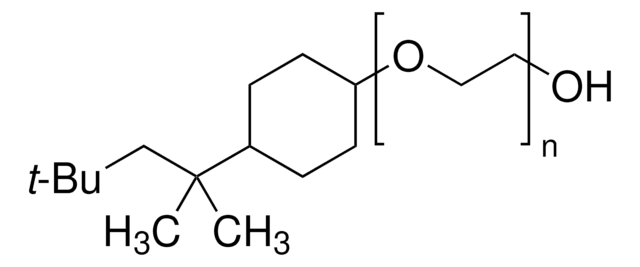X100RS
Triton™ X-100 reduced
Synonym(s):
Polyoxyethylene (10) isooctylcyclohexyl ether
About This Item
Recommended Products
biological source
synthetic (oragnic)
Quality Level
description
non-ionic
form
viscous liquid
mol wt
micellar average mol wt 80,000
average mol wt 625
aggregation number
100-155
refractive index
n20/D 1.473 (lit.)
CMC
0.2-0.9
mp
48 -50 °C (118 - 122 °F)
transition temp
cloud point 65 °C
solubility
water: soluble, clear to slightly hazy, colorless
density
1.029 g/mL at 25 °C (lit.)
absorption
≤0.25 at 277 nm in H2O at 0.5%
HLB
13.5
SMILES string
CC(C)(C)CC(C)(C)C1CCC(CC1)OCCOCCOCCOCCOCCOCCOCCO
InChI
1S/C28H56O8/c1-27(2,3)24-28(4,5)25-6-8-26(9-7-25)36-23-22-35-21-20-34-19-18-33-17-16-32-15-14-31-13-12-30-11-10-29/h25-26,29H,6-24H2,1-5H3
InChI key
QQJNBKDKLMCALZ-UHFFFAOYSA-N
Looking for similar products? Visit Product Comparison Guide
Related Categories
General description
In cell biology, Triton™ X-100 plays a crucial role in solubilizing membrane-bound proteins, preserving their native conformation in solution. Furthermore, Triton™ X-100 reduced, resulting from the full hydrogenation of the benzene moiety of TX-100 to a cyclohexane derivative, has been associated with potential benefits in enzyme digestion enhancement and effects on the photoisomerization of bacteriorhodopsin. The versatility of Triton™ X-100 in various research applications underscores its significance as a fundamental tool in biochemical and cell biology investigations.
Application
- in nuclear magnetic resonance (NMR) sample tube for lysing/rupturing the 1,2-dipalmitoyl-sn-glycero-3-phosphocholine (DPPC) phospholipid vesicles
- in cell permeabilization
- as a component in Tris/HCl to determine hydrolysis of the esters for enzyme activity assays
Features and Benefits
- Non-ionic surfactant
- Improves solubility and dispersibility of substances
- Excellent wetting properties
- Enhances emulsification
- High purity product for research applications
Preparation Note
Other Notes
Legal Information
comparable product
signalword
Warning
hcodes
Hazard Classifications
Aquatic Chronic 2 - Eye Irrit. 2 - Skin Irrit. 2 - STOT SE 3
target_organs
Respiratory system
Storage Class
10 - Combustible liquids
wgk_germany
WGK 3
flash_point_f
235.4 °F - closed cup
flash_point_c
113 °C - closed cup
ppe
dust mask type N95 (US), Eyeshields, Gloves
Certificates of Analysis (COA)
Search for Certificates of Analysis (COA) by entering the products Lot/Batch Number. Lot and Batch Numbers can be found on a product’s label following the words ‘Lot’ or ‘Batch’.
Already Own This Product?
Find documentation for the products that you have recently purchased in the Document Library.
Customers Also Viewed
Our team of scientists has experience in all areas of research including Life Science, Material Science, Chemical Synthesis, Chromatography, Analytical and many others.
Contact Technical Service






